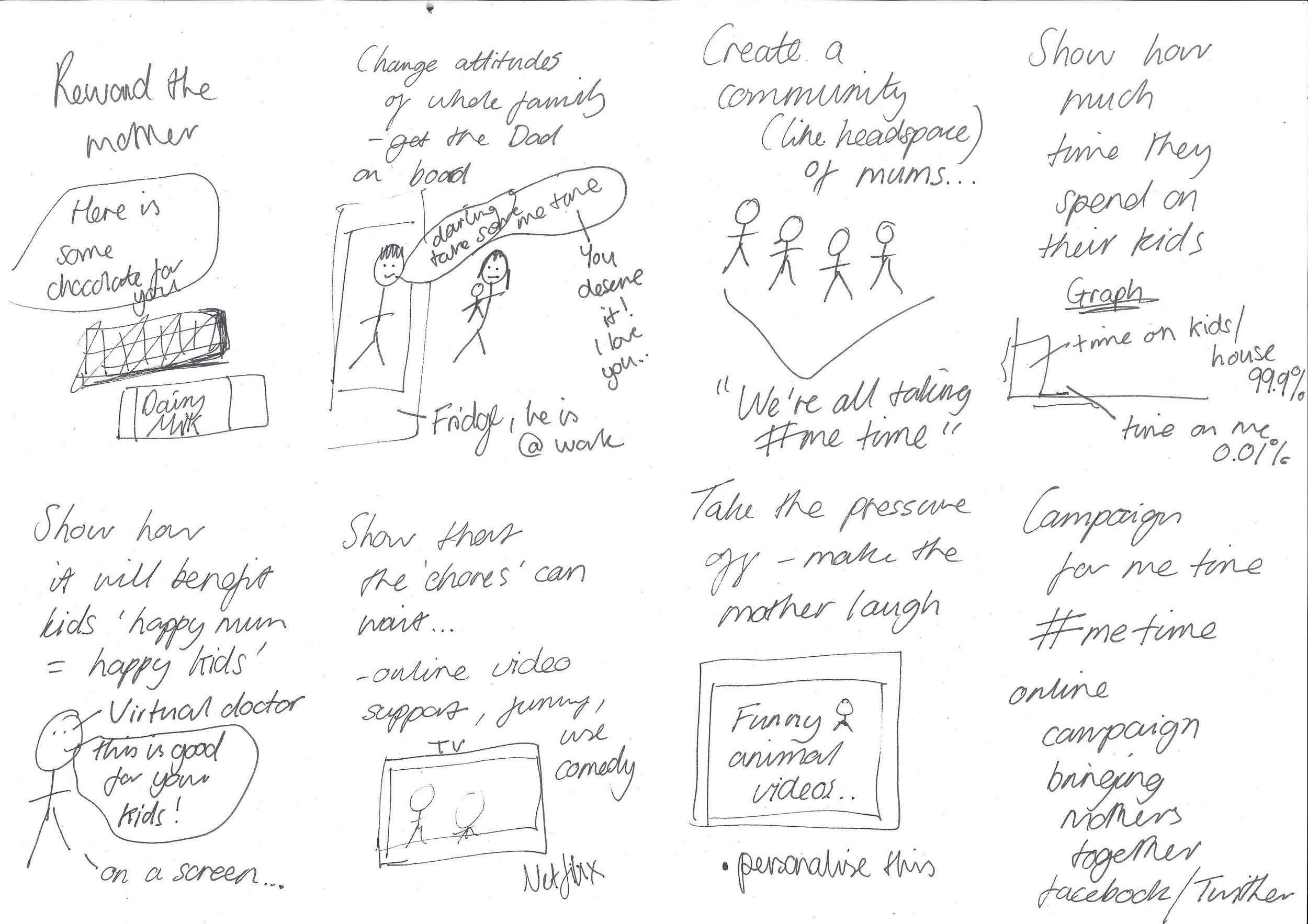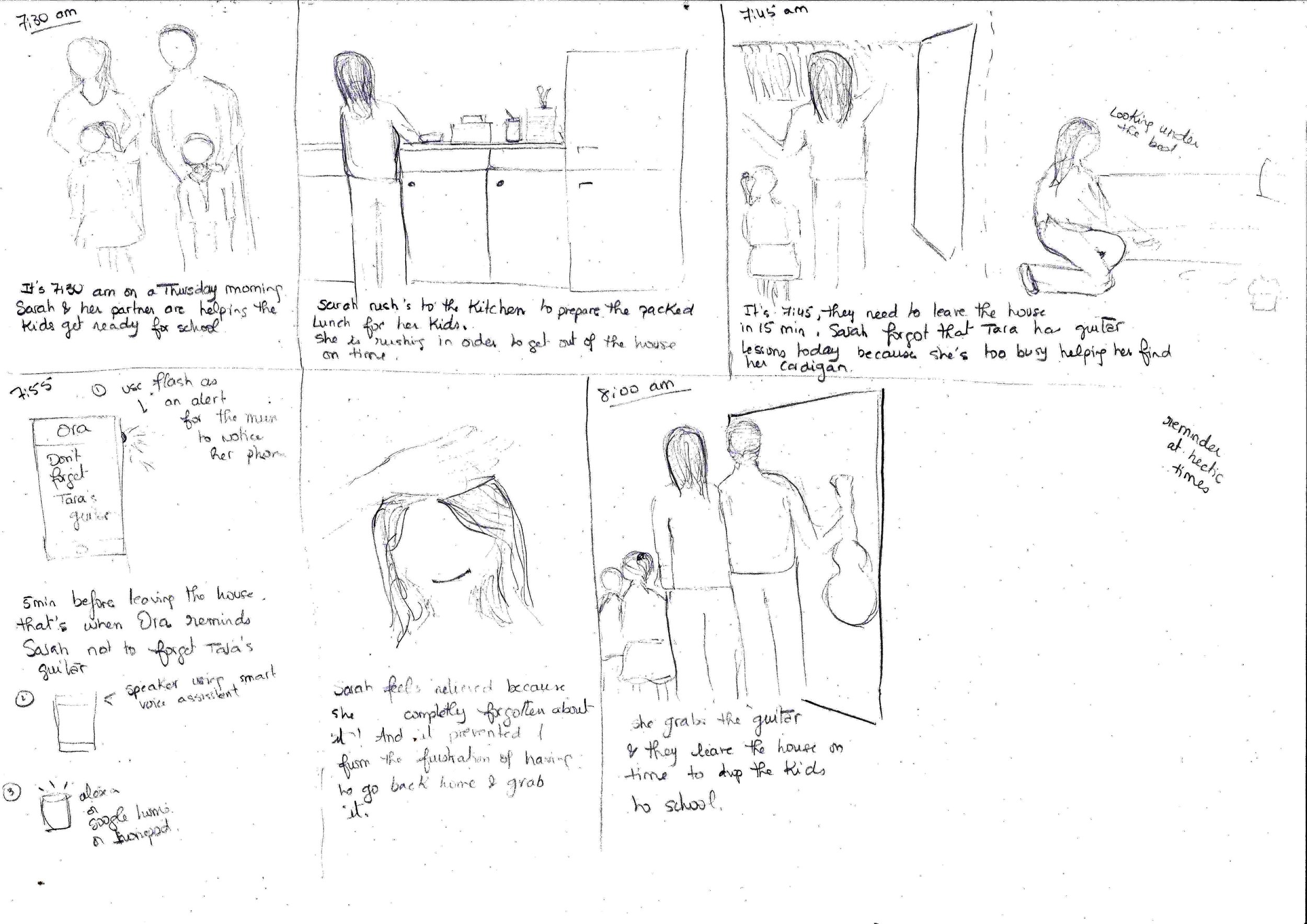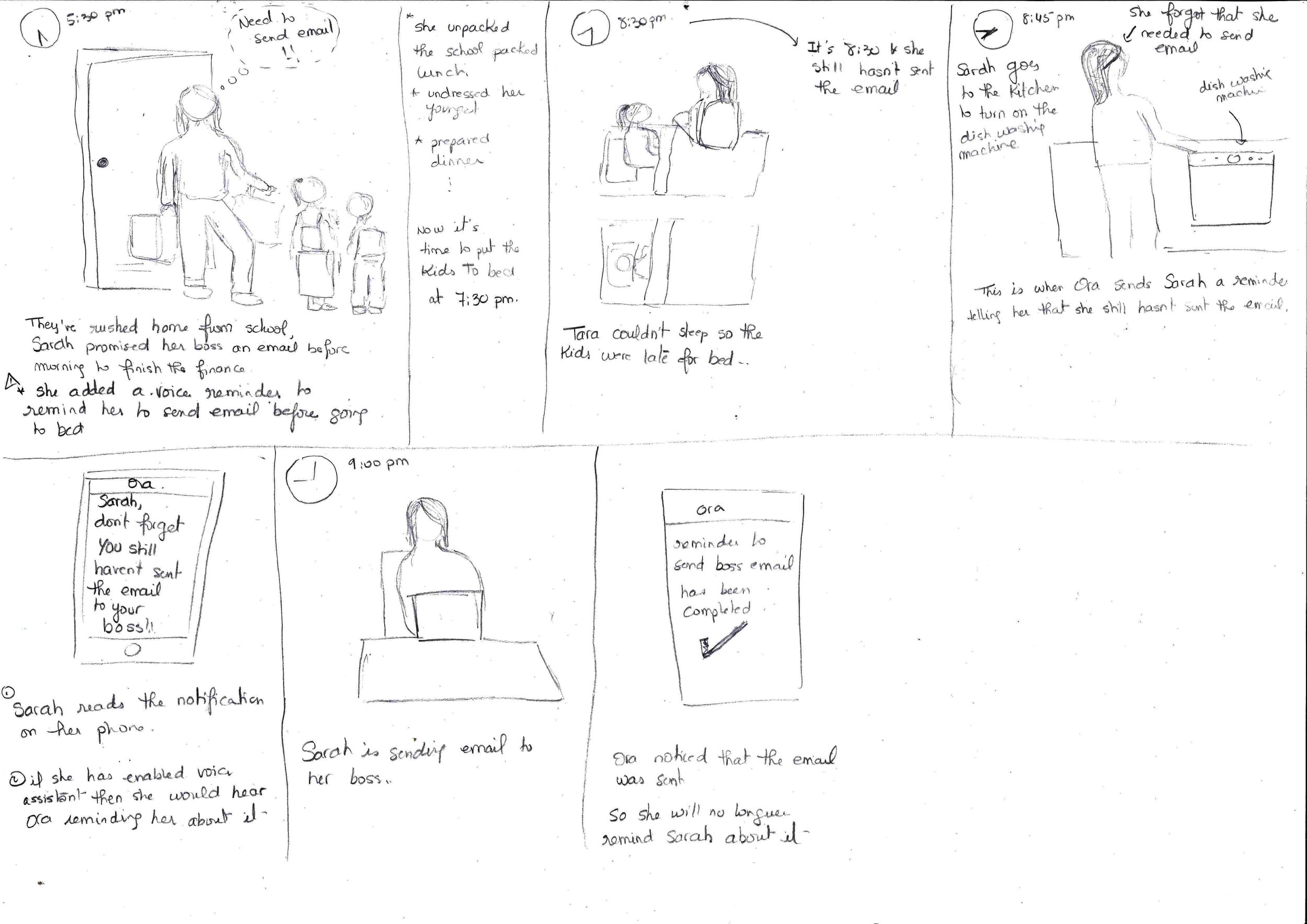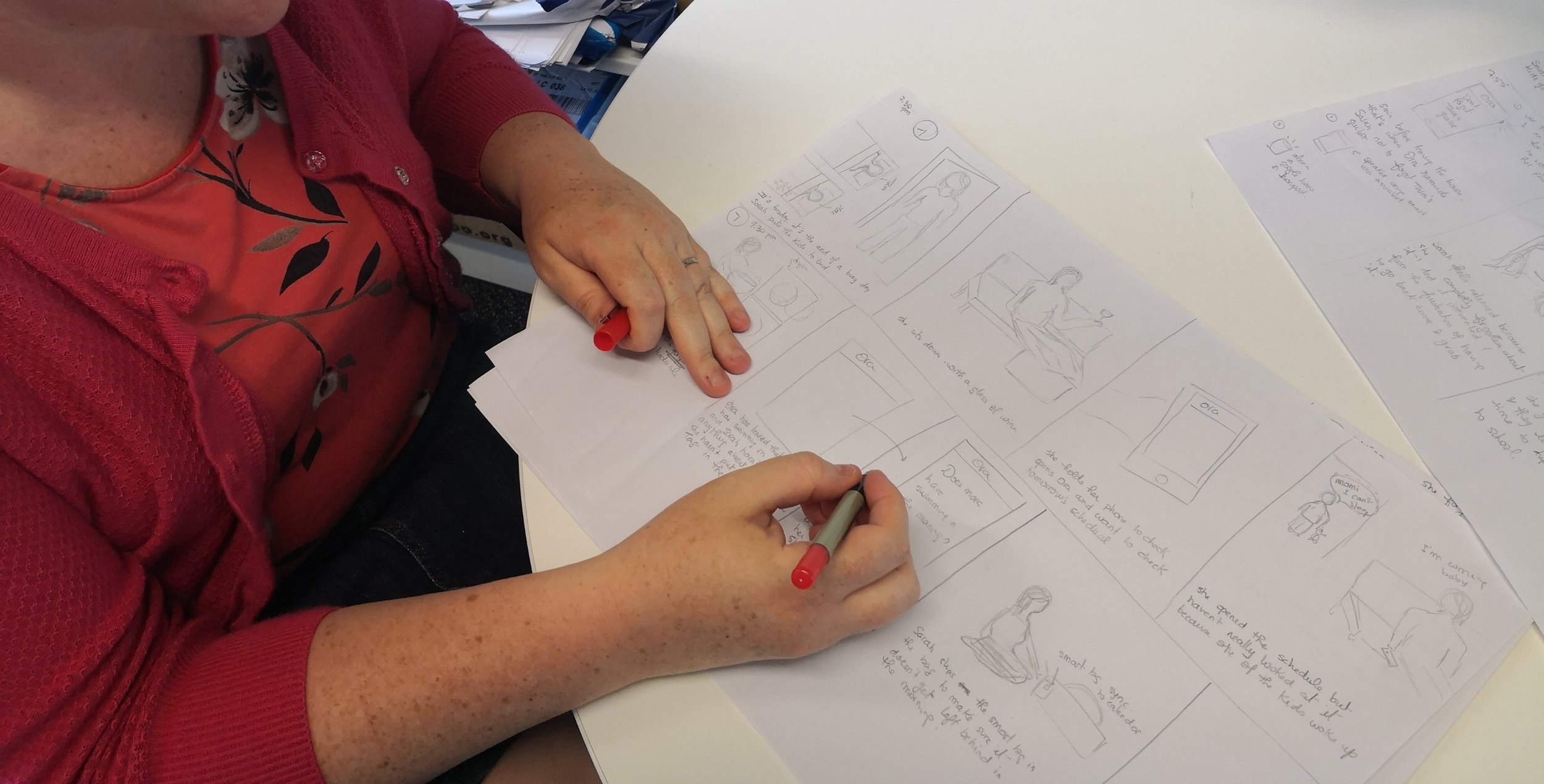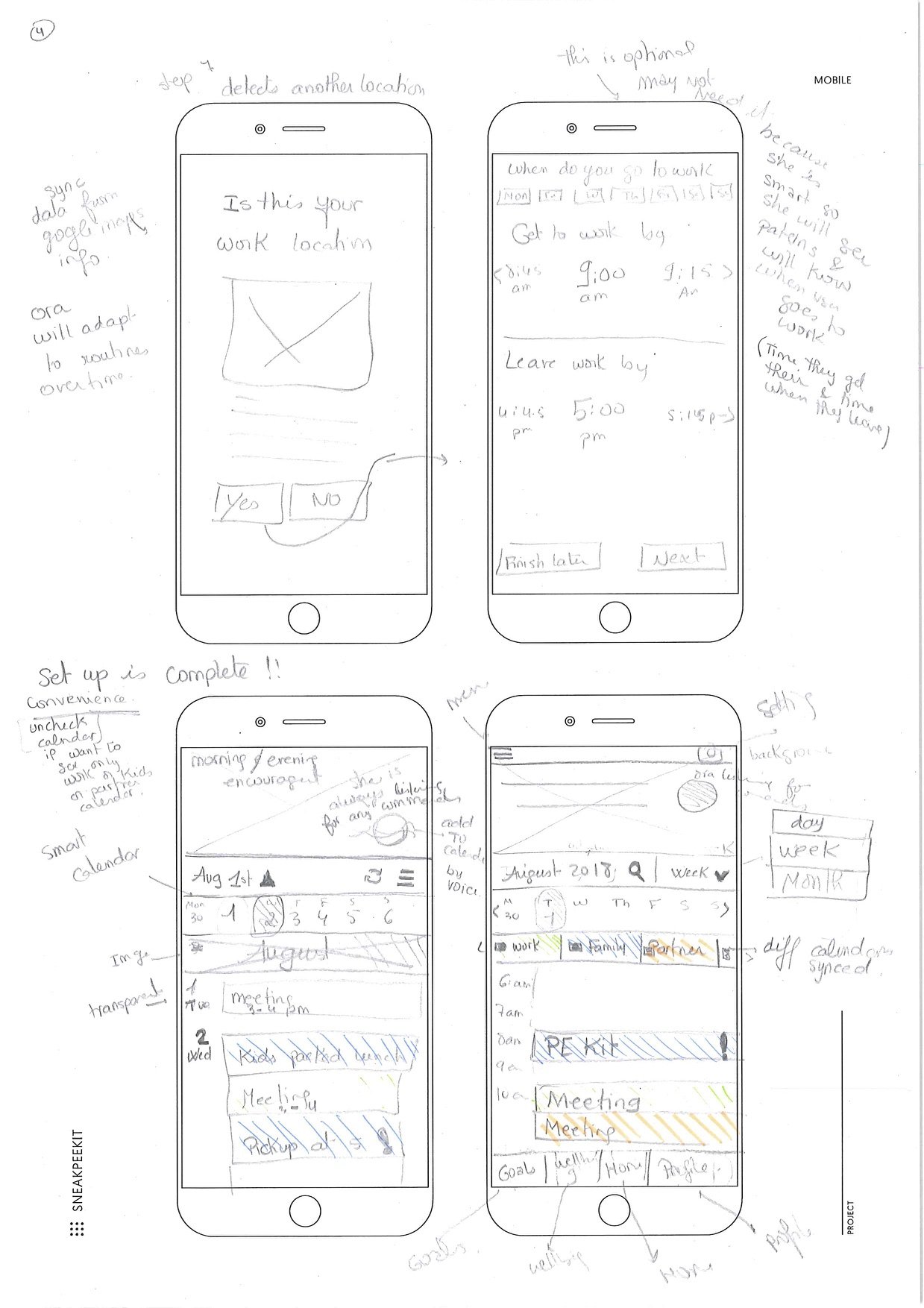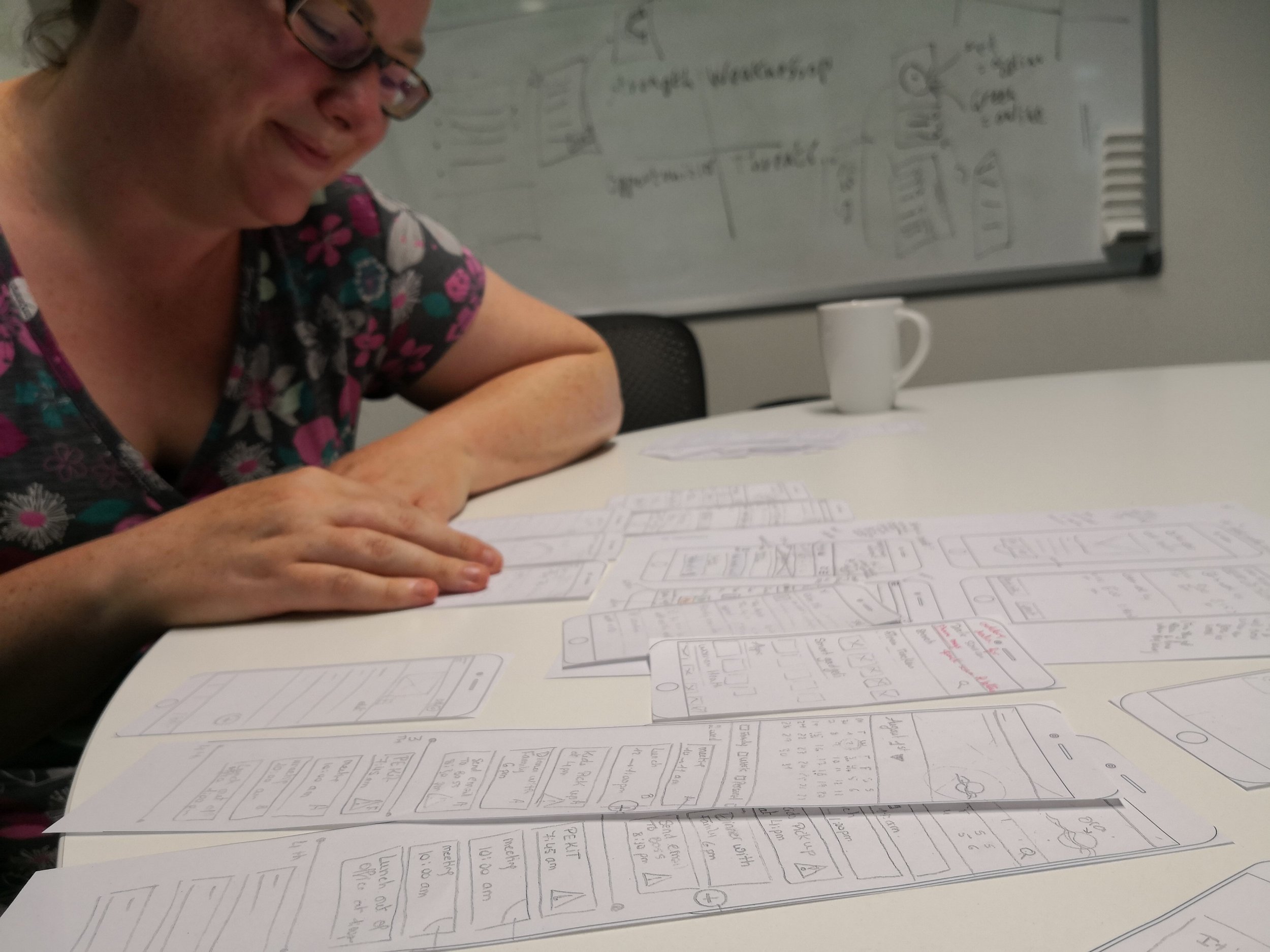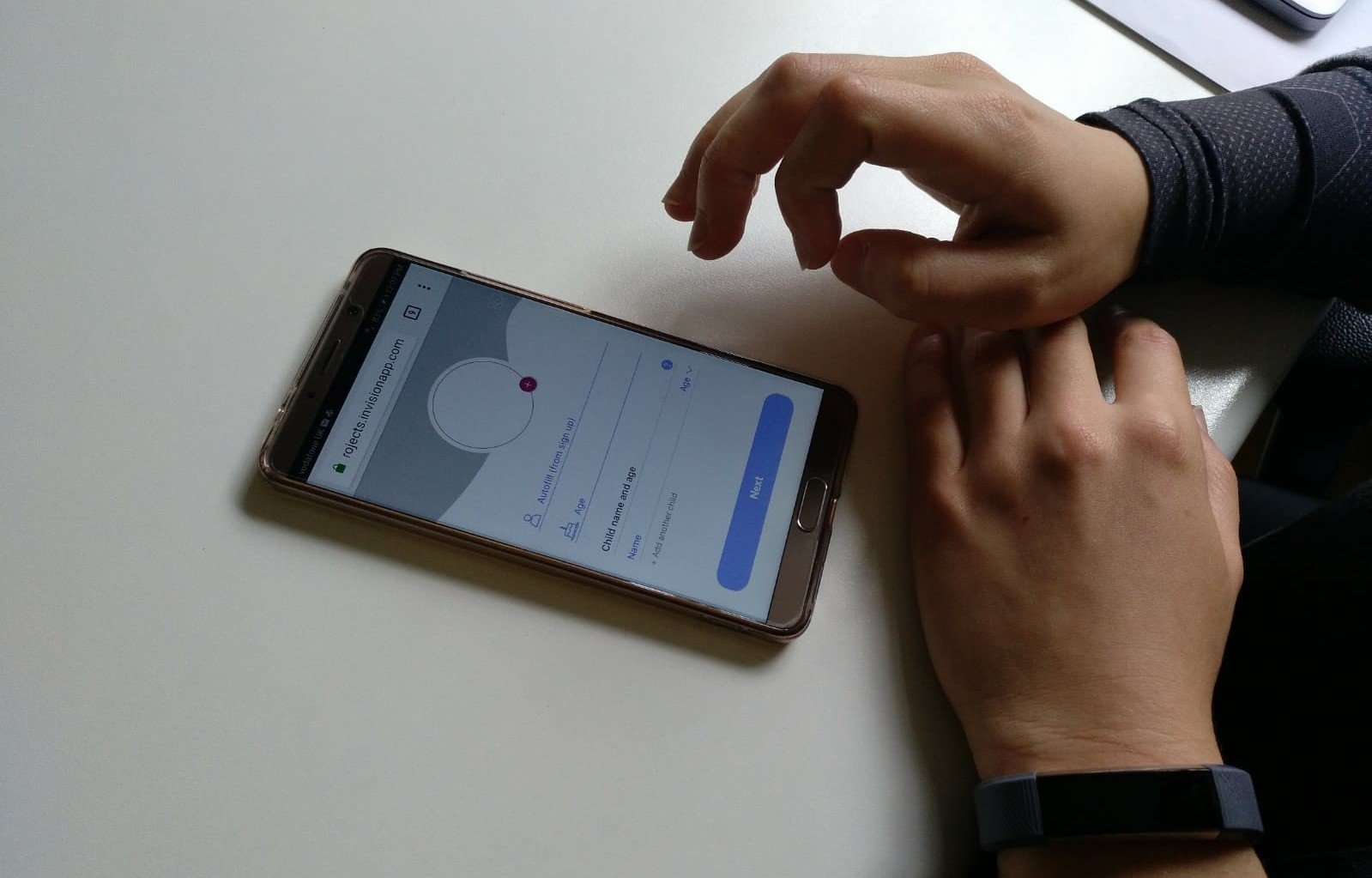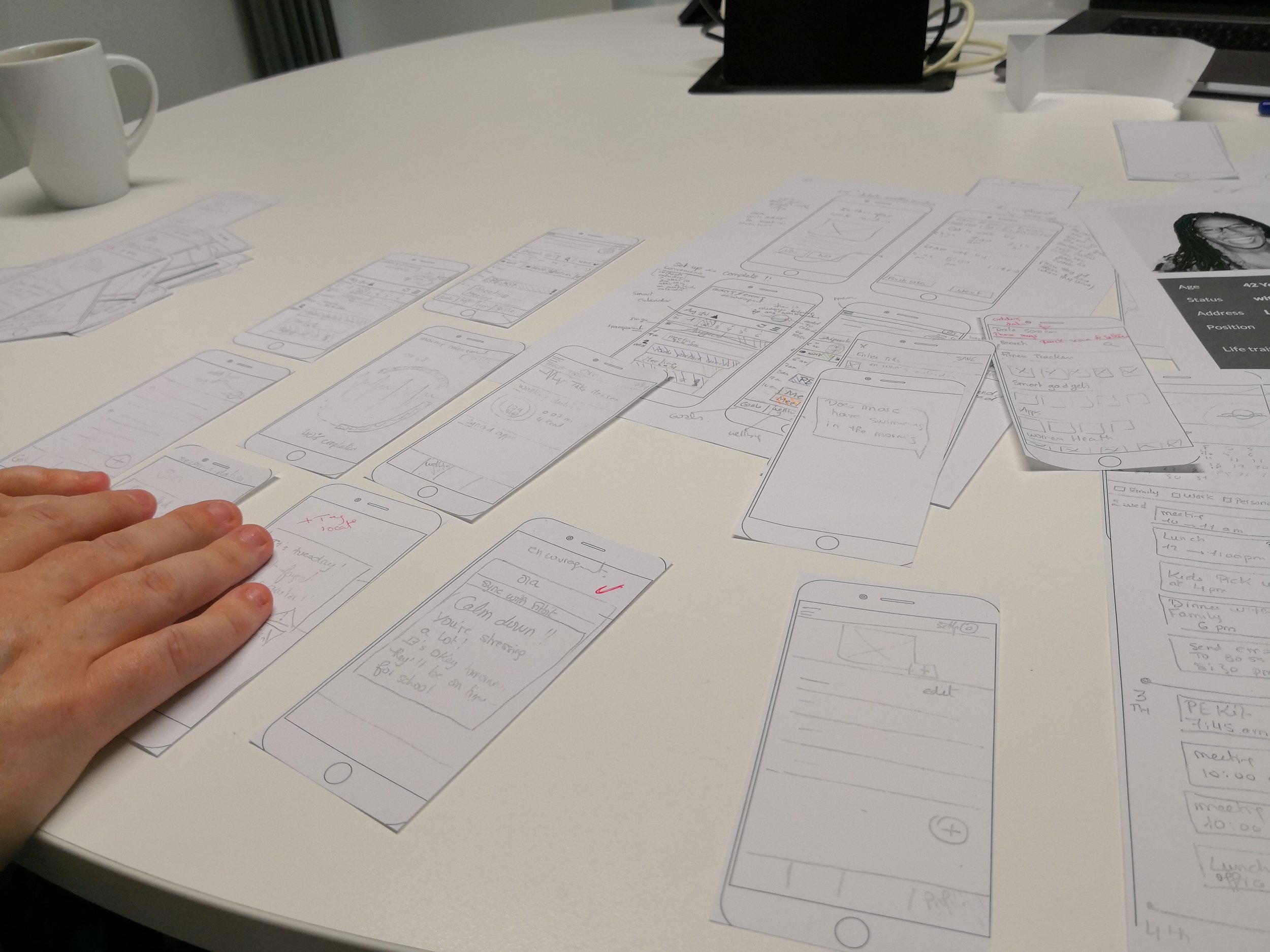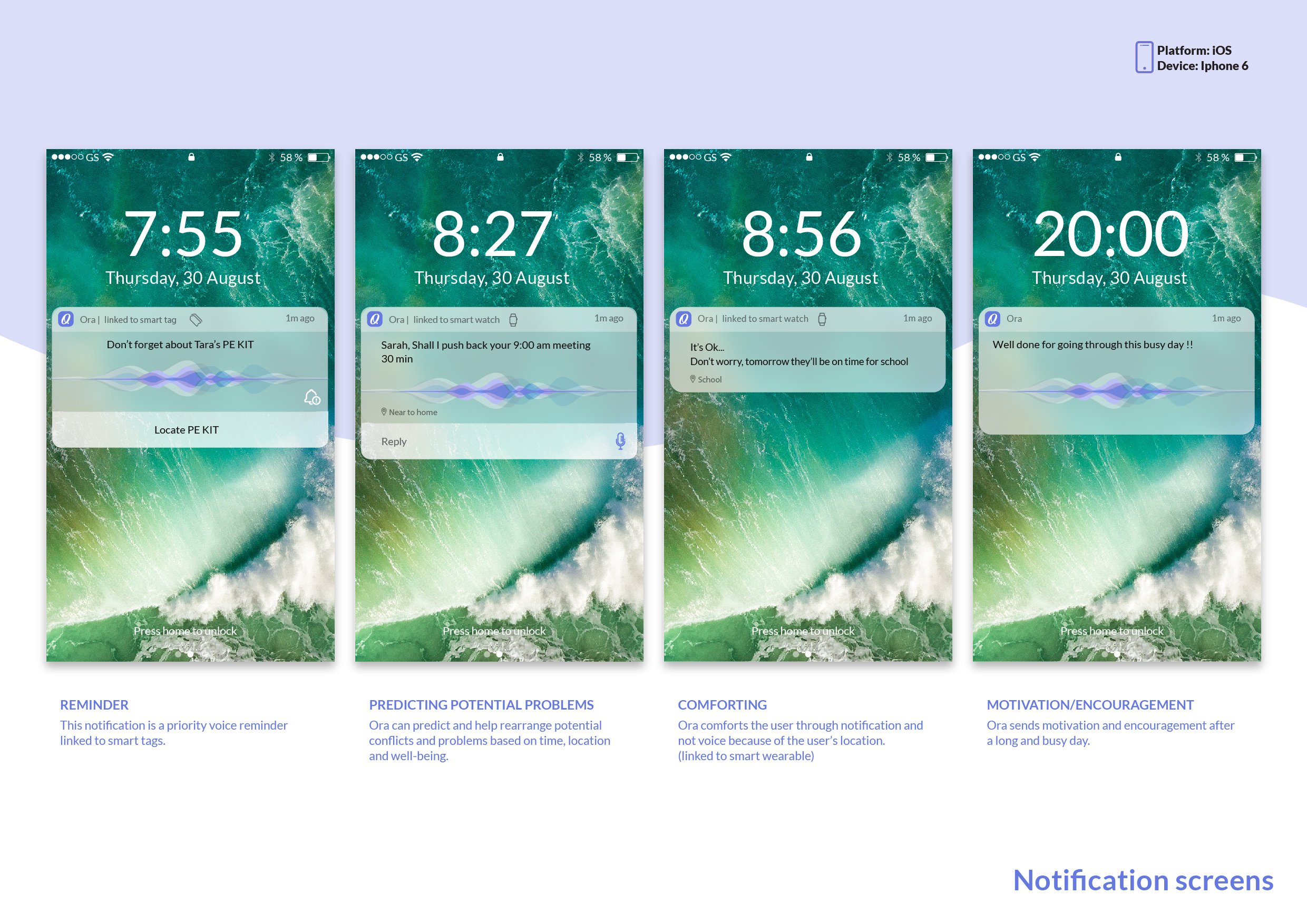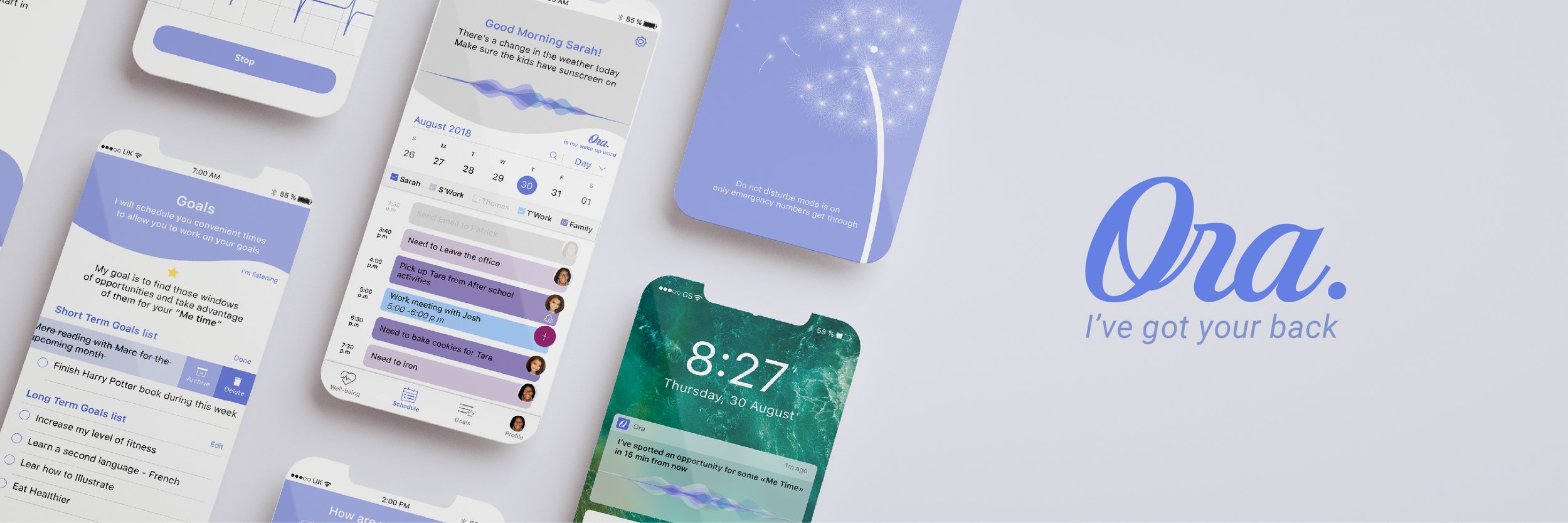
Overview
Ora is an intelligent smart personal assistant app for busy working mothers, offering personalized and intelligent assistance that empowers them to take guilt-free "ME TIME" while still ensuring the needs of their young children are met.
It empowers them through
• Timely reminders at hectic times
• Smart family scheduling
• Taking care of their well-being
UX Vision
& Design Principles
There is an opportunity for a product or service to help facilitate the lives of busy working mothers of young children. It will aid in making the mums feel less guilty and finding more time for themselves. It will also help in scheduling and remembering by potentially providing an intelligent scheduling smart digital personal assistant.
In addition, by assisting the mums with scheduling, remembering and all basic everyday tasks, the mindset regarding
“Me Time” will also be altered with time.
Responsive
Design Principles
Supportive
Companionable
Like talking to a friend
Approach
This project followed the Double Diamond, made up of four phases, as a model for an iterative and user-centered workflow.
Five research methods were conducted in order to understand the current experience of being a working mother:
Semi-structured interviews, Card sorting on a timeline, Shadowing, Storytelling and Ethnography.
Four analysis tools were used to cluster emergent themes and draw findings, key insights, and pain points.
HMW questions were created from the Key Insights to help generate opportunity statements leading to the crafting of the UX vision. MoSCoW Framework was employed to define what the final concept Must, Should, Could and Would be.
In the final phase Paper prototyping was the first level of user testing and from there, a high-fidelity prototype was developed and tested for final iterations.
Semi Structures Interview
The interview was comprised of twenty-three questions, which were all answered by 5 mothers, all of whom have at least one child under the age of 10. This allows the collection of a detailed level of information. One of the questions required information regarding a mother’s child care support network. It was answered through a map which allowed them to visualise what is personal to them.
The mother is the core; she is the centre. The participants have to draw or write the names of the people that belong to her support system on the available rings. The closer the person is to the core (the mother) the more important the role they have in her life.
Card Sorting on a Timeline
This method was conducted on six participants where each of them was provided with a Kit that includes a set of cards that they can shuffle around on a timeline to narrate how their morning went. The card sorting focused only on the morning because it would be hard to shadow the participants at that particular time of the day.
Shadowing
Shadowing focused on the afternoon of a mother’s day, specifically, picking kids up from school because the participants were more willing for the researcher to accompany them, share their experience and they were a bit more relaxed than in the mornings.
Storytelling
The participant was asked to narrate in detail what she did from the moment that she left her work to pick her child up from school until she reached home
Ethnography
Participants were provided with a narrative camera for a day that they need to wear from morning till night time but can remove during work. This method was used to capture how a mother’s day starts before heading to work, her daily routines, the tasks that she has to do, the things that might go wrong, the way she handle all of it, where she needs help in order to see how can a smart personal assistant enhance her experience.
RESEARCH METHODS
RESEARCH ANALYSIS TOOLS
Comparing a mum’s morning and afternoon
Affinity Diagram
Chaos
Always in a Hurry
Rushing
The participants' responses to the question about a digital personal assistant revealed valuable insights into their needs and problems. All six participants expressed the desire for a prompt before leaving the house to ensure they have everything they need, indicating the importance of time management in the morning routine.
Mothers tend to panic and rush 30 minutes before leaving the house as things often go wrong. This domino effect includes difficulties in finding parking, children arriving late to school, and the mother being late to work. Mornings are described as a mad dash to get everyone where they need to be with everything they need.
In contrast, the afternoon is less stressful for mothers, with the main task being picking up the children from school. Time is more on their side in the afternoon, allowing them to rest and prepare dinner.
This comparison highlights the morning as a trickier and more stressful time for mothers.
The affinity diagram was used as an analysis tool to make sense of the collected interview data. Sticky notes were used to write down the interviewees' answers, and then grouped and organized based on emerging themes.
FINDINGS
The home environment | Level within a home
Stewart Brand's (1994) original diagram “How Buildings Learn: What Happens After They’re Built” includes a set of layers that influence how a building and its parts change as the time passes (figure 7). Based on that diagram, the concept of layers inspired the creation of a diagram regarding the different roles a mother has to perform within the home.
A mother's priorities revolve around her children, represented as the central layer. In addition to child-related responsibilities, there are household chores depicted in the second layer. The mother's role extends beyond this as she is also a wife, with responsibilities towards her husband represented in the third layer. Once these layers are fulfilled, the mother can finally prioritize time for herself, depicted in the outermost layer. Once those layers are completed, the mum will have some time for herself and that’s why she’s represented in the final outer layer
Child Layer: everything related to the children. That includes social interaction, waking them up, taking them and picking them from school, spending time with them, feeding them
Domestic Layer: everything related to the chores around the house. Within a home there are sets of domestic jobs that need to be done (dishwashing, laundry, cleaning, ironing...). Regardless of what happens, these time-consuming chores need to be done.
Husband Layer: this ring focuses on the husband and that includes giving him her time and attention and not neglecting him.
Me Time Layer: this final ring represents a mum’s “me time”. Once the previous layers are completed, this will allow the mother to have time for herself.
Once one ring is successful, it will impact the one after. That is known as the knockout effect.
Therefore, the "Me Time" is represented by the outside ring. Once the mother completes the first, second and third rings, she will then have her "Me Time". And when all the layers have been completed, that will create windows of opportunities for the mother to have her “Me Time”.
Mapping the experience of a mother
To analyze the image data, the investigator organized the pictures from the wearable camera on a timeline to depict a typical day for a mom. The images were then color-coded based on different categories:
Blue represents interaction with the kids (child care).
Green represents interaction with domestic household tasks.
Yellow represents interaction with the husband/partner
Red represents the mom's "me time."
This color-coded system helps categorize and understand the different aspects of the mom's day captured in the images.
The dominant color in the household is blue, followed by green, yellow, and red, reflecting the mother's priorities.
Her focus is primarily on her children, followed by home-related tasks and communication with her husband/partner. Personal time for herself is the last priority.
While the household lacks a rigid routine, certain fixed activities occur daily, such as:
The child going to school or nursery
The mother going to work
Having dinner
Going to bed
These are fixed but a lot of different and unexpected things can happen in between to which a smart assistant wouldn't understand the context of.
The analysis revealed that the layers of the home are not sequentially organized but rather erratic, with "Me time" occurring at different times throughout the day."
Findings Conclusion
One mother stands out as she carves out an hour or so of 'Me Time' after her kids' bedtime. She indulges in a bath, a drink, and reading, unlike other moms who lack such moments. Their days revolve around work, house chores, and childcare, leaving no time for personal relaxation.
The lack of 'Me Time' emerges as the biggest pain point for moms who already juggle multiple roles - office worker, caregiver, homemaker, and partner. Allocating time for themselves significantly helps them manage their responsibilities.
The most common words used by mothers are "stressed," "worried," "rushing," and "challenging". Beyond a reminder from a digital personal assistant, what mothers truly need is uninterrupted time for themselves, separate from work. With their day fully scheduled, they have no free time. A prompt or reminder from a digital personal assistant would greatly assist them in remembering important tasks, making their lives easier and bringing them closer to achieving "Me Time."
It would be interesting and helpful if this digital personal assistant had another level where she would help the mother have some "ME TIME" during her day. Hence providing the mom with valued experience. In other words, it would be to design a smart digital assistant that will aid in making everything easier and achieving daily tasks better and quicker, which will automatically leave room for “Me Time”.
KEY INSIGHTS
The household environment is spontaneous.
Mothers need to adapt their behavior based on different scenarios, depending on their child's daily mood. If the child falls asleep, it creates a window opportunities for the mother to attend to other tasks. If the child is ill, challenges arise.
There is a perception that working moms struggle to balance their job and family responsibilities effectively.
Mornings are chaotic and challenging for mothers, often described as a "MAD DASH."
Working mothers find solace in knowing that other moms share similar experiences with their children.
Mothers devote less time to themselves compared to other family members.
A mother's priorities are her children, followed by household responsibilities, spending time with her husband, and if there is any leftover time or energy, she can have her "Me Time."
Mothers often overlook their "Me Time" in the quest for work-life balance, forgetting their own need for personal time as a working parent.
A mother needs to distinguish between “Me Time” and “Spare Time” and remind herself that she is a person in the midst of it all.
Get mothers to develop their mindsets, to want and feel that it's OK to have "Me Time" and not feel guilty about it.
This project aims to go beyond simply providing mothers with a smart personal assistant. It is a behavior change initiative focused on persuading mothers that it is perfectly acceptable to take a break. It involves helping them understand that finding the time for themselves is a matter of logistics, while prioritizing self-care is a mindset shift.
HOW MIGHT WE QUESTIONS
HMW create space and inclination for that
"Me Time"?HMW get mothers not to feel guilty about having some "Me Time"?
HMW help mothers remember that there is their "me" aspect?
HMW change a mother's mindset? That it is ok for her to take a break
HMW show mothers that it is not selfish to look after themselves and that it's not poor use of their time?
HMW take advantage of the little pockets of spare time and change them to "Me Time"?
Four analysis tools were used to make sense out of the collected Data
Comparison between a mother’s morning and afternoon
Affinity diagram
Mapping the experience of a mother
Development of new conceptual frameworks and module: The home environment
This tool used the data from all card sorting on a timeline (see figure 1 as an example) , shadowing (see figure 2 as an example) and storytelling in order to compare the morning and the afternoon of a working mother.
FINDINGS
In the morning, the challenge is getting everyone ready and out the door on time. Participant 5 stated that the priority is getting the kids to school/nursery so the mother can make it to work on time. However, there are tasks that need to be completed before leaving the house. Unfortunately, things don't always go as planned, and there are potential issues that can arise (refer to Table).
keywords used by mothers to describe their morning while conducting the research method:
Mornings are MAD
Things go horribly wrong
Mad dash
Morning is a struggle
Crafting a UX Vison Statement
UX Vision
Defined Problems:
The woman often forgets, as a working parent, that she needs time for herself .
Mothers need to distinguish between Me time and Spare time.
Mothers need help in remembering things.
There is an opportunity for a product or service to help facilitate the lives of busy working mothers in the UK with young children under the age of 10. It will aid in making the mums feel less guilty and finding more time for themselves. It will also help in scheduling and remembering more things by potentially providing an intelligent scheduling smart digital personal assistant. In addition, by assisting the mums with scheduling, remembering and all basic everyday tasks, the mindset regarding “Me Time” will also be altered with time.
DESIGN PRINCIPLES
HOW MIGHT WE (HMW)
Defined Opportunities:
There is an opportunity to support the mums in planning, scheduling and remembering things, which in return will aid the mums in wanting and feeling that it’s alright to have “Me Time” and not feel guilty about it. The goal is to get mums to develop their mindset.
UX VISION
The assistant has to be Responsive: The Smart personal assistant will learn and respond to user’s needs
It’s like talking to a friend that will be able to help and support the mum
It has to be Companionable: Not only will it be a voice in the house, but it can also be with the mother wherever she is or goes
It has to be Supportive: This assistant has got their back and will help them better organize their time and life, which will help them feel supported
The initial “How Might We” statements were revisited and the creation of new “How Might We” questions were developed with the integration of technology, social, and UX trend.
How might a smart personal assistant enable the mum with some me time?
How might we make “Me time” become a habit/ part of her daily routine through the use of smart personal assistant?
How might we use voice assistant to assure the mum that other working mums are having “met time”
How might we use the principles of service design to create a community for working mums that can develop their mindsets to want to have “me time”
Design and Development
Concept Generation
Co-design activities were carried out with two colleagues to generate diverse ideas. Using Google Venture's Crazy Eights method, we rapidly sketched eight concept sketches within an 8-minute timeframe, allowing for unrestricted creativity in terms of complexity and feasibility.
Idea 1
A smart scheduling digital assistant that will aid in making everything easier and achieving daily tasks better and quicker, which will automatically leave room for “Me Time”.
Idea 2
Using virtual reality. For 15 minutes in a day, the mum would wear a VR mask that can take her to a place where she can do and be whatever she wishes to be.
Idea 3
Introducing a smart wearable that records partner and/or kids' voices or videos and projects encouraging holograms, promoting "me time." It tracks stress levels and fatigue, adjusting the holographic projections accordingly.
Idea 4
Smart wearable that detects a mom's stress and fatigue levels, alerting her about her well-being and encouraging "me time".
Idea 5
A smart home device that tracks and categorizes time spent on house, kids, and self. It projects the data to highlight each category, especially self-time
Idea 6
A campaign for “me time” #Me time that empower working mothers to take me time. Slogan “bringing mothers together”.
Balancing scheduling and "me time" was crucial, leading to idea number 1 as the most promising option. The opportunity lies in supporting moms in planning, scheduling, and valuing their "me time" without guilt.
Discussions focused on whether scheduling or encouraging "me time" should be the key feature. The aim was to strike a balance between the two, shaping the product's overall personality.
Potential features of the smart personal assistant
Smart scheduling with multiple calendar synchronization
Prompt reminders related to kids can have a transformative impact on a mother's day
Detection of mother's stress level and mood-enhancing features like playing favorite playlists or providing encouraging statements
Concept statement
It’s a [Digital] [personal assistant] for busy working mothers that empowers them to take Guilt Free “Me Time” whilst still meeting the needs of their young children.
It empowers them through
Timely reminders at Hectic times (prompts using voice)
Smart Family Scheduling of Daily Tasks (in the background about things that need to be done)
Rewarding them when “Off Duty” for making time for themselves (help people understand “me time”)
Developing Details of the Project
The researcher utilized Kano analysis to determine the product attributes that have the greatest impact on customer satisfaction. Based on the analysis, it was concluded that an app would be the most suitable form for the smart personal assistant. The app received the highest scores in terms of functionality and satisfaction. Therefore, the researcher is developing a minimum viable product through the app to ensure responsiveness, companionship, support, and a conversational experience similar to talking to a friend.
By focusing on the app as the smart personal assistant, the researcher aims to deliver a product that aligns with customer expectations and preferences, providing a high level of functionality and satisfaction.
MoSCoW Method Framework
The app enables mothers to measure their heart rate using their phone's camera and flash, accommodating those without a smart wearable. It learns the user's normal patterns over time and considers additional input about daily feelings for better data analysis.
With the key user requirements set, this allowed for moving forward and developing the feature sets.
Voice-activated personal assistant
Syncing multiple calendars
Prompting users during busy times
Smart tags for reminders and locating objects
Syncing with other apps for well-being information
Sending encouraging and comforting notifications
Identifying and utilizing free time for personal time
The app's ecosystem can stand alone but can also integrate with wearable devices and smart speakers, adding value to the user's experience. Wearables provide more accurate data on heartbeat, activity, and steps. Smart speakers enable more sensible prompts and recommendations. The app evolves over time by recognizing patterns and adjusting accordingly.
To use the product, the app is necessary, while wearables, smart speakers, and smart home devices enhance the experience. The app's ecosystem relies on wireless connectivity, internet access, and cloud-based technology for data sharing between connected devices and the cloud.
Branding the App
Considering the target audience of working mothers, the name "Ora" was chosen for the digital personal assistant. Inspired by the researcher's own orchid and the concept of "Aura," defined as the distinctive atmosphere or quality surrounding a person, thing, or place, Ora represents the supportive presence that surrounds and assists the mother whenever she needs it. Ora has got her back.
Persona
For a user centred design, the crafting of a persona that “consolidate archetypal descriptions of user behaviour patterns into representative profiles of the target users” was needed to humanize design focus, test scenarios, and aid design communication”. Sarah, a 42-year-old working mum of 2 kids, was created based on the collection of attitudes and behaviours that emerged from participant research.
Context scenarios
Once the persona was ready, different context scenarios for each must-have were created based on the persona's task goals.
These scenarios were used to identify key user journeys for the user experience
Co-design session
The researcher met with one of the target users to share and discuss the various context scenarios. Subsequently, storyboards were created to gather feedback on the concept and refine the researcher's understanding of the user's requirements through suggested improvements.
Storyboard
Sitemap
Before wireframing, having a sitemap is crucial as it helps clarify and organize the app's content. This process defines the app's features and user journeys, ensuring a better user experience. The site map identified four key screens: Scheduling, Well-being, Goals, and User Profile
After preparing the site map, multiple hand-drawn wireframe screens with different options were created to breakdown each feature from the sitemap into screen-by-screen layouts, content and functionality.
Evaluation
Low fidelity paper prototype testing
Low fidelity paper prototype was tested in order to resolve identified issues and improve the design based on user feedback.
By implementing the received feedback from the users during low fidelity prototype, improvements were made to the design communication of the app. The app screens were more refined, representing the appearance of the final app‘s look and feel. The final user interface design and interaction design was driven through consideration of user goals, user journeys and scenarios.


















